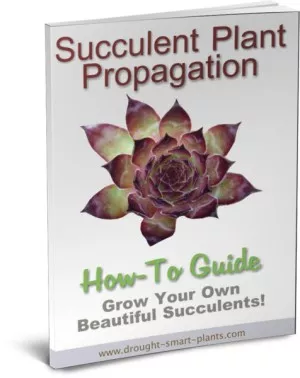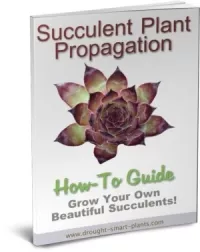
by Noni
(BC)
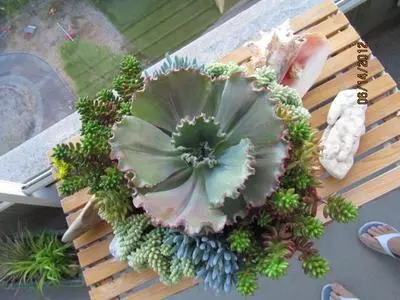


I live on the 11th floor south west facing in a suburb of Vancouver.
Do I leave this succulent planter out on my deck for the winter? Or do I take it indoors when the temperature gets down to freezing or below? Do I need to cover it for frost?
Do I water it at all over the winter? I have not watered it for at least a month now.
Do I need to take the succulents out, and replant them in fresh soil in the spring? I hate to lose them. Thanks so much!
Hi Noni, nice planter – I can see why you would not want to lose those, they’re gorgeous. These all look to be tender succulents, so no, whatever you do, don’t leave them outside. It’s just not worth the risk of losing them.
The big rosette is some type of Echeveria, and the pale blue green one is Sedum morganianum, the burros tail sedum. Several others I don’t recognize, but they all look to be tender succulents.
Why not sign up for the free Overwintering Tender Succulents E-Course, where you can find out more about what these plants need to stay healthy and happy through the winter.
My 2 Wicker Coffee Cups
by Mari
(Florida)
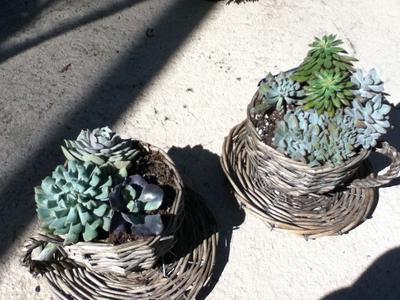



Hi Jackie. Need your help identifying some of my succulents. I believe I have E. Perle Von Nurnberg and E. Topsy Turvy but I am not familiar with the others. In the 2nd photo. there is a red/purplish succulent I can’t identify. In the 3rd photo, there is also one succulent that is similar with the E. Topsy Turvy but the stem is different (it’s flat and wide with leaves shorter). Just a little bit of help. Thanks.
Hi Mari, those are definitely Echeveria, as far as I can tell – but you’re right that they don’t look exactly the same as what you normally see as Topsy Turvy. The taller green one I would suggest some form of either Echeveria setosa, or a hybrid between E. setosa and pulvinata; there are many with varying degrees of hairiness.
The other purple one is most likely another of the many hybrids in the trade. Have a look at this site for more pictures, maybe one will be similar to yours.
Hope that helps – by the way, I love your coffee cups, very cute!
Jacki
No idea what this beauty is…
by Darren Makings
(Bairnsdale, Australia.)
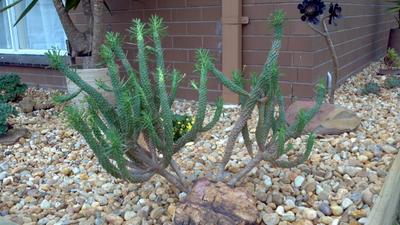
Got given this by a neighbour, it looks amazing but have no idea what it is?
That certainly is a beauty – the stems are quite distinctive and the form is quite exciting, adding a ton of character and interest to your garden.
This looks to be some kind of Madagascar palm, or Pachypodium geayi – here is another different one that looks similar: Pachypodium lamerei.
These interesting plants resemble a cactus, but apparently prefer a little more water to look their best.
Enjoy your fabulous plant!
Jacki
Planter Box
by breanne
(california)
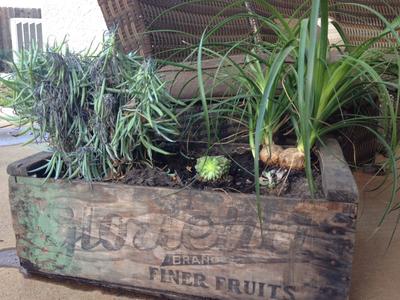
there are 4 different plants in this vintage fruit box, I don’t know what any of them are or what to do with them. As you can see the one on the left looks like it’s struggling, but maybe it’s normal? Please help! The box is just shy of 9″ tall. I live in zone 9b.
Hi Breanne,those poor things do look like they’re struggling. I only see three plants (the two bulb like plants I’m counting as one); I’m not sure what those would be, the scruffy looking blue one is Senecio mandraliscae or something similar, and the little one in the center looks like it might be some kind of either Echeveria or Sempervivum.
I’m thinking that it’s time to renovate this container – and change the soil. This looks like the type of potting soil that is made of composted manure or peat and manure mixed.
Succulents hate this type of soil, and although they might grow okay for a while, eventually, as the soil breaks down into smaller and smaller pieces, the pores in the soil get clogged and the roots of the plants suffocate.
I recommend using some kind of sterilized potting soil that has a peat base if that’s all you can find, mixed half and half with pumice, small gravel or other aggregate. I avoid perlite if possible, because it’s too light and will float to the surface of the soil.
You might be better to pot the bulb plants into a separate pot, take cuttings from the Senecio and discard the bottom part, and put them back into this great rustic box. If you’ve put the right kind of soil into it, they can just root right in place.
Hope this helps; buy the Succulent Plant Propagation E-Book to show you exactly how to take the cuttings off your plant. (Click on the picture below!)
Jacki
Wanting to learn more about Succulent Plant Propagation?
One long stalk and 4 sprouting leaves
by Math M.
(Ann Arbor, MI)
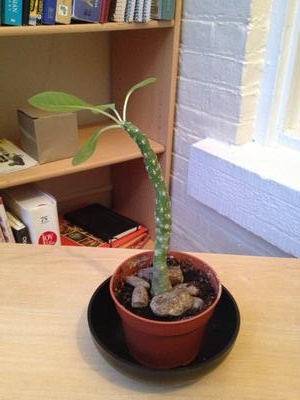
I just got this. Not sure what it is. It’s about 6 inches tall. 3-5 leaves sprouting from the top. Short roots.
Hi Math, this is possibly some type of Madagascar palm. These are odd plants, and generally do fine until they get too tall, at which point most people give up on them. Their botanical name is Pachypodium – I’m not really familiar with them so I can’t tell you much about which species this would be. You can see more on Dave’s Garden Website about Pachypodium geayi and Pachypodium lamerei.
The other alternative is Euphorbia, and I have to warn you about these plants: they have caustic sap, which is white, like latex. If you poke this plant and that’s what comes out, then you have partially identified it. You can see more about them here: Euphorbia.
Hope this helps narrow it down for you,
Jacki
Need to know what this plant is…
by Christian Davidson
(St. Louis, Missouri)
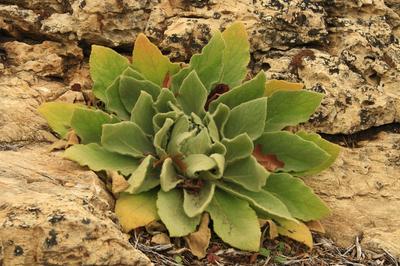
I can tell that it’s a succulent, but I don’t know it it’s an echeveria, a sempervivum, or something else entirely.
I don’t own the plant. It’s either there naturally or is part of some landscaping — probably the former — at Forest Park in Saint Louis, Missouri. I have no idea about its blossoms or soil. But I’d like to be able to add some more detail in my description of the photo. I’m a photographer and thought a capture of the plant would be nice.
Any help anyone could provide would be much appreciated.
Thank you.
Hi Christian, this doesn’t appear to be a succulent – I’m not 100% sure what it would be without doing a lot more research into native plants (if that is what it is) in your area.
However, I’m going to suggest that it could be some type of Verbascum, or mullein, which shows this rosette formation of leaves in the first year, then elongates into a very tall and impressive flower spike with yellow flowers (usually) which open in sequence over a long period of time in the summer.
As biennials, (plants that take two years to grow to maturity and bloom) these plants will die after they bloom, leaving the tall stalk to scatter the seeds far and wide over the winter.
Many insects love the blossoms, and if the seeds are left to ripen, I’ve seen downy woodpeckers either eating the seeds, or bugs that are attracted to the seeds.
Here’s an example of Verbascum epixanthemum which looks very similar.
That’s the best I can come up with, hope that helps narrow it down a bit.
Good luck!
Jacki
looks like a succulent, acts like one, but is it?
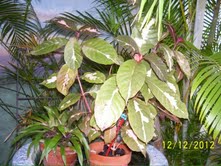



The plant has varigated green, white and reddish-pink color leaves. The stems are red and requires a lot of water or it wilts fast.
See Gary’s comment for the correct identification on this plant – who would have guessed?
Jacki
i’d really like to know what this succulent is. por favor 🙂
by Cody
(San Antonio)
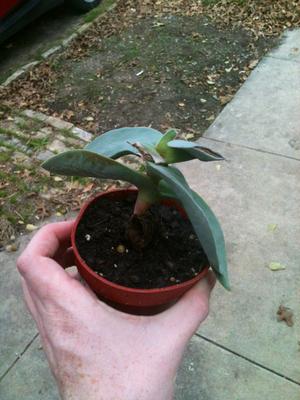
i actually forgot all about this guy last time i was repotting my other plants and i left him on a table outside. he doesn’t look to be in too good of shape or if he’s even alive, so i’m unsure if he’ll even survive. Please help me identify him so i can try to revive him as best i can.
He’s really fleshy feeling and has never been a really bright green since i bought him, more of a grayish-jade type color. idk lol.
Hi Cody – that looks to me like some kind of Cotyledon.
I’m not really familiar with the genus, but they all seem to have the really thick leaves.
The picture on this page seems similar, but I’m not sure it’s the same one.
The other possibility is a Crassula. This species seems similar.
It looks like the roots and lower part of the stem might possibly be dead, judging from the color.
If so, you might be able to re-root it by cutting the stem above the damaged part, and root it just like any other cutting.
Allow the cut surfaces to dry out and callous for a day or so before sticking the cutting into dry potting soil, with a good percentage of aggregate (gravel, pumice, perlite, whatever you have that will be fast draining).
I’m sure that with care, this little guy will recover – succulents are really so resilient, and they can surprise you when they spring back to life.
Best of luck!
Jacki
help i.d.
by Tracey
(Nowthen, Mn )
My mom had a plant, approx. 25 yrs. Ago~ much like hens and chicks. Only they were more rounded and grew outward with longer ”branches”. If a piece fell or easily knocked off, you could just put it in the dirt to start another. What kind of plant was this?
Thank you!
Hi Tracy, have you looked at any of the plants on these pages: Succulent Plants miscellaneous or here: Echeveria. There are many other plants that are similar, so without seeing a picture of your particular one, it’s impossible to tell.
The many different hybrids of different genera especially those with Pachyphytum in their background tend to have this characteristic of the leaves falling off easily, and you can quickly have lots of them rooting under the mother plant if you happen to knock them off while handling the plant.
Hope this helps,
Jacki
pretty little girl (with roots?)
by Dennis
(Eagan, MN)
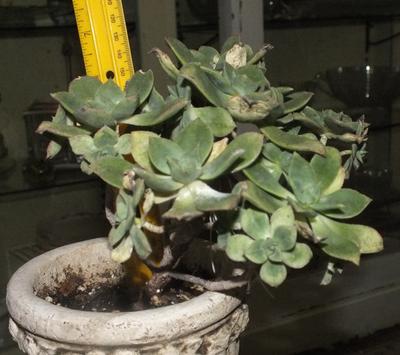




This little gal measures about 5 inches. Her leaves are on the top of her “woody” stems. Most of the stems have “strings” hanging on them and we assume they’re ready to plant themselves….but wait, do those ‘roots’ have to drop way down to the ground before starting other plants? Really enjoy this page and have identified several succulents we have.
Hi Dennis, that’s great that you’re finding this page useful!
A lot of succulents have such an ability to grow more plants from cuttings that they do it even before you cut them off – those are indeed aerial roots, which form and wave around in the air. You can easily and quickly propagate these types of plants by beheading them and planting the cutting. The aerial roots just prove how willing and eager they are to make a few babies.
This particular plant looks like one of the many gorgeous Sedeveria/Pachyveria hybrids, sorry I can’t tell you which one, they all are similar in care to Echeveria.
Happy Succulent Growing!
Tiny Buds
by Deanna Ciocco
(Saint Marys GA USA)
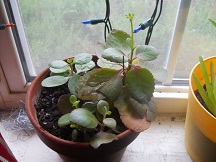
It has round green leaves and they have stems coming up through the leaves and one of them has a bunch of tiny buds developed.
Many leaves are a pinkish reddish color around the edges, and it’s starting to have buds.
Hi Deanna, the buds I would think are going to be flowers eventually, and without seeing more closely what this is I can’t say for sure.
The arrangement of the leaves – opposite each other in pairs – is a characteristic of many Kalanchoe species, but without more information about it, and a picture of the flowers it’s impossible to pin it down exactly.
If you do a search for that plant on the internet you might be able to spot a picture of it.
Sorry I can’t help more.
Just so you know, some of the characteristics that are common to plants in the same genus are things like the way the leaves attach to the main stem, and the vein pattern in the leaves.
Each of these characteristics can help narrow it down to one or another genus. If you send me more than one picture, especially of those things and the flower if it has one, I have a better chance of being able to help identify your plant.
Best of luck,
Jacki
Please help identify….
by Brian
(Vancouver, BC)
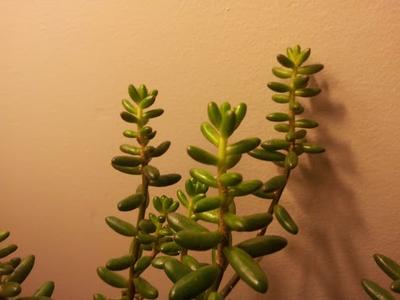
this succulent was purchased at home depot with no specific identification. little help, thanks.
Hi Brian, without some kind of indication of the size of this little guy, it’s hard to say. I’m leaning towards a type of Sedum, probably rubrotinctum. It’s also difficult to see the coloration, which depending on the length of time it was in the store, and will differ. I notice too that the internodes, the spaces between the leaves, are quite long – this indicates that it’s been kept in an area without much light.
There are many different Sedum that are sold as simply ‘succulents’ in these box stores, so pinning down exactly what it is is impossible.
You can see more about what these kinds of succulents need for care here.
Hope that helps,
Jacki
Tiny leaves, big red stems
by Ethan
(Michigan State University)
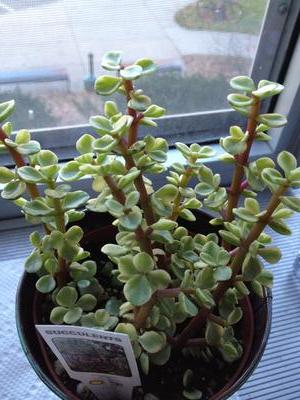
It is a small plant, puffy little leaves and has very thick red stalks and has about 10 of them coming from the soil
Hi Ethan, this is Portulacaria afra, and this one is a variegated form.
It’s known as Elephants Food, due to the fact that in Africa, where it originated, the elephants (and probably other herbivores) browse on it. This indicates its perfect ability to regrow from being pruned quite severely. In some areas where it’s hardy to grow outside, it’s used as a hedging material. I’m sure this looks very pretty.
You can see more about Variegated Elephants Food here.
Happy Succulent Growing!
Jacki
the leaves grow like palm fronds
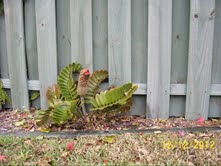




This plant has been growing for years.
It is all green, then one day it sprouted a growth in the middle of the plant. It looked like a brown uneaten corn cob.
It stayed that way for months, then when it finally bloomed, there were numerous teardrop red berries with some kind of sap.
Tried to dry the berries out, all they did was shrivel. Haven’t been able to find out if its a succulent, cactus or what. Thanks for your help.
This plant does not look at all familiar to me. It’s not a succulent, or a cactus.
You haven’t said whereabouts you are, so I have no way of knowing if this is a native plant, or even how hardy it is.
If it’s hardy in your area, that would help to know what your climate is like, for starters.
Sorry I can’t help without more information.
Best of luck identifying your great plant.
Jacki
stonecrop succulent
by Marie Soren
(Canada)
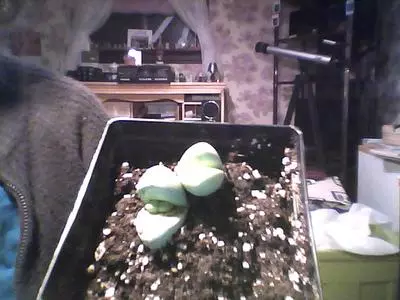
It looks like two fat fingers split in two and inside are two more little ones. It seems the plant is just starting and the only name they gave me at the store is stonecrop succulent.
Thanks for helping me… Here goes the picture
Hi Maria, this is definitely not Sedum, which is what I refer to as stonecrop. I’m always astonished at how mixed up the names get in the industry. I would probably call this ‘living stones’ or ‘split rocks’ which it looks more like. These are Conophytum or Opthalmus, two separate species that grow in this fashion, with two new ‘leaves’ emerging from in between the two old ones. Generally, that’s all you get, the older leaves shrivel and dry out after producing the two new ones, but eventually you’ll get quite a cluster, because in time they’ll actually make more than one new set.
You can see more about a related ‘living stones’ or ‘pebble plant’, the Lithops.
Hope that helps with your ‘stonecrop’ which isn’t.
Jacki
Furry leafed succulent
by Deborah Brunelle
(El Cerrito, CA, USA)
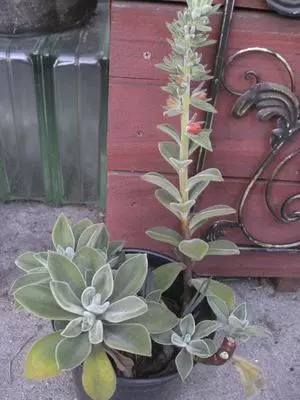
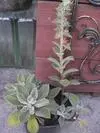
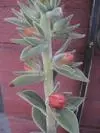
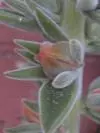
Thick stems, can twist, can lie on the ground, and as in this photo can grow upward also.
Leaves are semi-thick and furry/fuzzy/soft.
Found in the San Francisco Bay Area of California.
I’ve never seen them blooming… but this one that I just threw into a pot temporarily a while ago has started to bloom!! It’s beautiful.
Hi Deborah, you’re right, it is beautiful! I have never seen this plant before, although it does look similar to some types of Echeveria, it seems to have a few main differences, like the multiple crowns, and the way the flowers are produced in the axils of the leaves.
Other than that, it seems to be something related to that genus, or a similar one.
Hopefully someone will see the post and chime in, if they know what it is. Leave it with me, and I’ll try and hunt it down.
Jacki
succulent growing from tubers
by jeff
(DE)
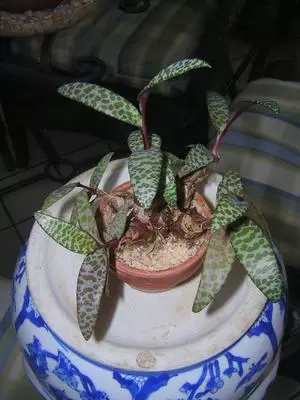
Please help to ID my succulent. It has narrow leaves that have dark green blotches on a light green background. The leaves are growing from tubers above the soil. The plant is small (about 4 inches tall) and the leaves are 1/2 inch wide and 1 1/2 inches long. I have had it about 3 years and it is now about twice the size as when I got it. Thanks.
Hi Jeff, this is one of my favorite little, low maintenance plants. I use it combined with other succulent plants as a foil to their fleshy foliage, and it’s totally okay to grow alongside them.
It’s called various names, but the most often used common name is Leopard Squill, and it’s also listed under some different botanical names: Ledobouria violacea is one that I have seen many times, and also Ledobouria socialis. Whatever you call it, it’s adorable and sweet.
This post has another type.
Hope that helps give you somewhere to start,
Jacki
You can see it used to great effect in this gorgeous planter.
long stem, green leaves, white flowers
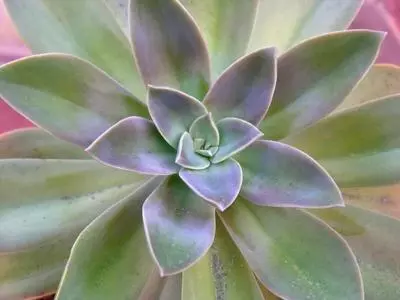


I suspect that this plant is an echeveria, but I cannot determine the species. The leaves grow at the top of a stem and are dusty-green in color. It will produce petite white flowers.
I do believe you’re right, and it’s pretty near impossible to figure out the species or variety as there are so many hybrids. The white flowers are unusual – most Echeveria have red, pink or orange blooms, so if you find out more about those that have white flowers that would narrow it down.
Great to see that you’re propagating it from leaves – although this takes a long time to see results, you can build up your stock with lots of nice healthy baby plants. I find that growing my own from cuttings or leaves is much better than trying to salvage an older plant for instance.
Happy Succulent Gardening!
Jacki
See more about Echeveria species and hybrids here, and find out more about how to grow Echeveria.
flowers only after dark
by maureen
(budgewoi nsw)
Very long green straps for leaves.
I have it in a basket, although it will climb on a wall. The flowers are white as big as a saucer; very beautiful. The flower only lasts one night.
I think it is a succulent; not sure but would like to know name of it.
Hi Maureen, even without a picture, this is obviously the plant known as Queen of the Night, for good reason. Yes, it’s a succulent, which only refers to the plants ability to store water in its leaves.
You are right about it climbing on a trellis, it grows some strange spindly stems to help it to find a support, and will grow quite happily against a wall.
You can see more about these plants here: Hylocereus undatus and some related plants here: Epiphyllum, the Orchid Cactus and Schlumbergera, the Christmas Cactus.
Hope this helps,
Jacki
Three Small Succulents
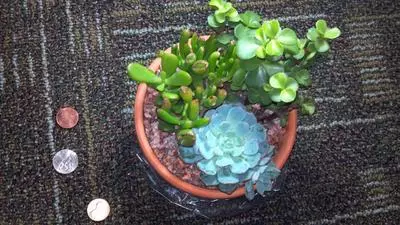
All of the succulents together w/ size comparison




There are Three Succulent plants I have in a pot, that did not come with any identification.
They are:
A small, rounded one that sort of resembles an opened pinecone, with a smaller one next to it. Looks like a member of the echeveria family to me.
A medium sized (relative to others) tubular-looking cylindrical green plant. I’ve had no luck identifying this one to any level.
A larger (relative) wood-like-stemmed plant. Seems to me like something in the Crassulaceae family.
I’ve included 4 pictures:
1 of all of them, with coins for relative size.
and
1 of each of the 3
As a budding botanist myself, I’m dying to know what these are. Let me know if you need anymore information.
Thanks!
Hi JK, these all look to be some of the most common succulents that you will find in box stores and garden shops. From the top:
1) Tubular; this is Crassula ‘Gollum’ or Goblin Fingers; I’m not surprised that you couldn’t find it, because it doesn’t look anything like any other in the genus. You can see more here: Crassula
2) Rounded; this lovely blue plant is one of the Echeveria; there are many different ones, and some look so much alike that they are hard to distinguish between. You can see more about Echeveria here.
3) Wood Like Stem; This is Portulacaria afra, the Elephants Food, which can get to be a fairly big shrub in its native habitat (in Africa) but grown in a container, stays compact and well behaved.
All of these are great little plants for getting started – welcome to my obsession!
Jacki
Possibly Echeveria??
by Angela
(Wisconsin)
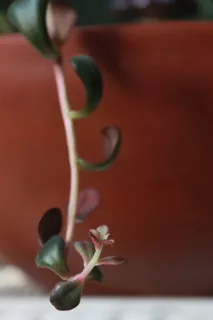
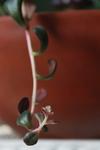
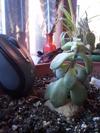
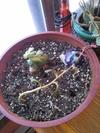
Okay so I have two plants that I inherited from my work place.
I think the stubbier one is some sort of Crassula, but the vine one has left me scratching my head.
The vine one is about 5-6 inches total in length and the stubby one is about as tall as a computer mouse when you stand it up.
I’m thinking the long one is some sort of Echeveria, but I couldn’t really find anything that matched them on the site. Perhaps it’s some sort of hybrid?
Hi Angela, it can be really misleading when you’re trying to identify plants that have been grown in the worst conditions possible. Something this stretched and etiolated will be nearly impossible to identify accurately.
I would probably try and take a few cuttings which, given more suitable conditions such as bright light, might be more indicative of the genus and species they belong to.
Sorry I couldn’t give you any real ideas about this,
Jacki
Learn how to root your own succulents:
Unknown Bog Plant
by Irene
(England)
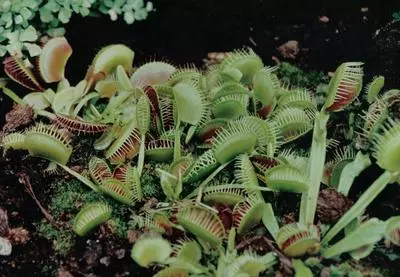
Flycatcher?
Looks like some form of fly catcher
Hi Irene, that is indeed the Venus flytrap, or as it’s known botanically as Dioneae muscipula.
These are carnivorous plants, meaning they eat meat – but having no legs to chase them down, they need to attract the flies to them. They do this with scent, and then once the flies attempt to find out where the lovely smell is coming from and step on the sticky pad, the trap is sprung. The leaves close trapping the unwary insect inside. Enzymes do the work of turning the insect into a yummy meal.
These plants grow in wet areas, and are happiest in boggy ground, which never dries out. They do well in the same conditions as Saracena, the pitcher plant, and Drosera.
Dionaea muscipula is the botanical name, and this link has some useful information about this plants needs.
Good luck with your Carnivorous Plant!
Jacki
Mystery plant found in UK greenhouse
by Jenny
(Derby, UK)
It´s only a baby so it´s about 2 inches tall, but it seems to have grown from the compost we´ve been using to grow vegetables in our greenhouse this year. We live in central UK so we´re a bit confused as to how a succulent got there at all, but we´ve potted it and brought it inside and it seems to be doing well. It has round leaves and red flowers. Can you help us please?
Sorry, Jenny – without a picture, I’m lost! Have a look through the pages linked from the column on the right of the main page here: Succulent Plant Identification; maybe you can see something similar.
Good luck with your search!
Jacki
Pink bell-shaped succulent flower
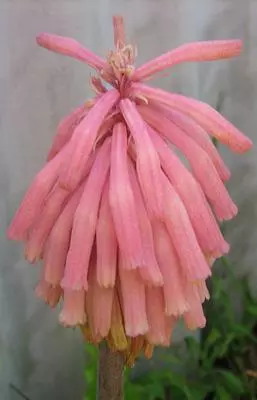
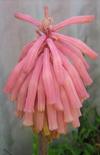
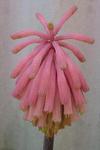

Pink falling trumpet-like, bell-shaped succulent flower growing on a purplish 15mm stem to about 500mm in height with quite long deep green leaves broadening from 25mm at the base to 60mm at the tips.
Hi Danny, boy ain’t that purty? I wish you had sent a picture of the leaves because without that I can’t really narrow it down. When I first saw this I thought immediately of Kniphopia, which is also known as Red Hot Poker, but there are also some Kalanchoe that have this same type of flowers. Can you email a picture of the bottom of the stem and the leaves? That will help identify it for sure.
Jacki
vine of hearts
by Karen
(14424)
Hello,
I have a small hanging plant that has tiny heart shaped leaves on it. It is solid green, but I’ve seen it speckled also. They are very slow to get growing but then they grow about average.
The leaves are very close together on almost straight thin vines/branches.
I found it once but do not remember where, just that it said it was a succulent, though not always categorized as such.
Thank you, Karen
Hi Karen, without a picture, it’s absolutely impossible to tell you what this might be.
Until you described it as having the leaves close together, I thought it might be some kind of Ceropegia, but many of those have long internodes (the space between the leaves on the stem) which would rule them out.
Sorry I can’t help.
Best of luck with your search,
Jacki
mystery trailing plant
by Mary
(Alamosa, CO)
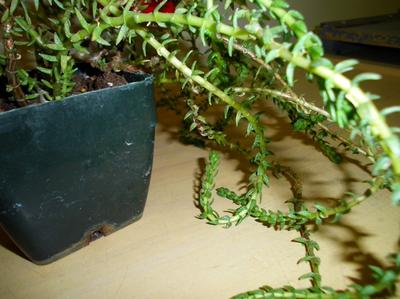



purchased at a fundraiser… no idea what this is. Any help would be much appreciated. It seems to be an indoor plant. We are high alpine desert, so it wouldn’t last outside through the winter. :o)
Hi Mary, I don’t know about that – this looks like a Sedum reflexum that has been grown without much light, making it stretch to reach for more. I would at least try some outdoors, you might be pleasantly surprised to see how it thrives in your conditions. You can see more here: Sedum reflexum.
Let me know if this is it,
Jacki
Help identify a blue foliaged plant with orange flowers
by Lence Mrgja
(Skopje, Macedonia)
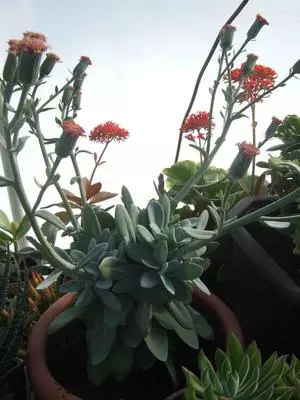
Hi
I brought this plant from Norway,have no idea about the name.
We have a succulent and cactus nursery and trying to expand and to buy some seeds, if you can help us regarding this.
Thank you,
Lence
Hi Lence, from the looks of the flower, this is a type of Senecio, or Kleinia which is the old name. This page on Dave’s Garden Website shows a similar plant, but only one in bloom so it’s hard to tell if it’s the same plant or not.
For seeds, I’ve found very few reliable sources, but one that you might try is Mesa Gardens in New Mexico – I believe they ship all over the world, so you might be able to find what you want there.
Best of luck in your exciting journey!
Jacki
Madame Blueberry
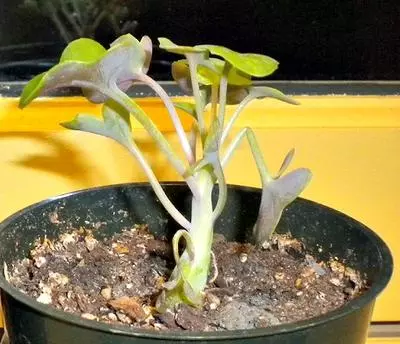
I have an unidentified plant from a college greenhouse. It is about three inches tall, and has arrow-shaped leaves. The leaves are a light green color on the top, and a blueberry-purple color on the underside. The bases where the leaves branch out are also a purpley color. When under direct sunlight, the leaves appear bright green and are almost sparkly. What is it and how should I care for it?
Boy,nothing about this plant rings a bell for me. I would think that if you possibly could get a hold of the teacher of the horticulture department, the college where you got it might know.
It looks fairly healthy, so whatever you’re doing, keep it up!
Best of luck.
Jacki
What is my bosses sad looking succulent?
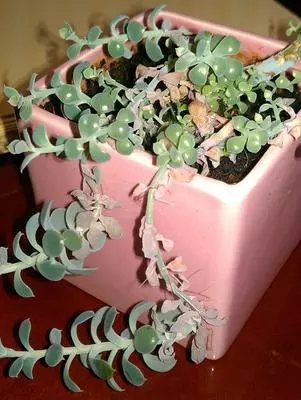
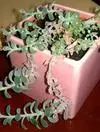
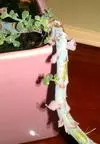
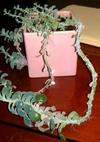
I’m trying to save my bosses broad leave vine type succulent. Before I do anything I want to find out what it is and treat/save as instructed. The leaves fell off on good portion of the mature vine and it seems to be sprouting new growth. It’s dull green but probably should be more jade plant green. I’m not sure. I’ve never seen it healthy.
Seeing how a plant is supposed to look when it’s growing well and thriving certainly will give you something to aim for.
This poor thing is some type of Echeveria, but it’s been sadly neglected, although judging from the way the leaves look, there is still hope.
Here’s what to do – it won’t be pretty, but sometimes you have to be cruel to be kind:
Cut it right off at the base, leaving only an inch of old stem.
Take the pieces you’ve pruned off and cut them into about one inch lengths, and let them dry off – this is important – do not water them! Put them bottom side down into some dry potting soil – preferably mixed with any type of aggregate such as small gravel, pumice or perlite, whatever is available. These will root, and the bottom part which you’ve salvaged will grow new sprouts.
Here’s the really important part; these plants originate in extremely bright and warm conditions – you must copy this to have any chance of success.
This means, as obviously the place where this poor plant was left to struggle along was too dim, you will have to get a grow light.
You can find them fairly cheaply online – get one that is for a single plant, and put this plant under it. You’ll be shocked at how quickly it recovers, and in time it will regain its former beauty.
Best of luck with your project!
Jacki
Wanting to learn more about Succulent Plant Propagation?
thick, waxy, rounded-tip leaves 4″to 5″
by Theone Perloff
(New Orleans, LA)
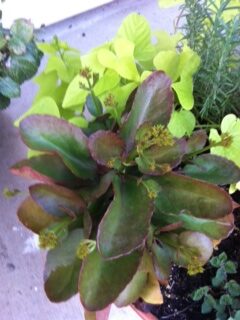
I think this is a Kalanchoe, but would appreciate an accurate identification if possible.
Hi Theone, that does indeed look like on of the many Kalanchoe species – one of the characteristics that is common in this genus is the arrangement of the scalloped leaves, in pairs and oppositely arranged on the stem, and ending up in a cross configuration.
This one is unusual in the pinky coloration.
Here are some possibilities:
Kalanchoe blossfeldiana – there are many hybrids, in all color combinations of foliage and flowers, so maybe revisit these when your plant blooms.
Some of the difficulty in identifying this incredibly large and diverse genus is that one particular species or variety acts and looks completely different in various growing conditions, heat, watering schedule and day length. These chameleons of the plant world continue to fascinate and amaze.
Best of luck with your lovely plant,
Jacki
Stemmed succulent with small leaves
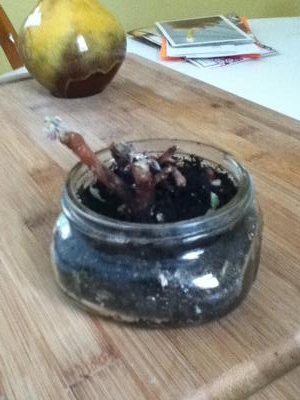
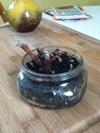
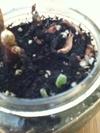
I bought this with a few other succulents for wedding decorations back in May.
It’s about an inch tall and has two different stems each with two branches.
The stems feel fairly sturdy and are somewhat fuzzy. It grows small oval shaped leaves that are also fuzzy and fall off very easily.
I think it bloomed during the summer, but I don’t remember what colour the flowers were (or if it even did for sure!).
I included a close up on some of the leaves that I’m trying to grow into plants. There aren’t currently any leaves on the plant itself. They all died while my husband and I were on vacation last week.
What can you tell me about this plant? I can’t seem to find pictures of plants like it anywhere!
Without seeing a picture of what the plant looked like originally, it’s really difficult to say what it could be.
When I hear of the description that the leaves fall off easily, this is an indication that it could be some kind of Echeveria hybrid, which have this trait. It also looks like some of the leaves have fallen onto the soil, and have rooted. This also is typical.
I have a suggestion, and that is to move those leaves out of that type of soil, which looks like it’s;
A) the wrong kind of potting soil – possibly manure or compost based where succulents mostly prefer to be in a sand based soil, and;
B) if that container does not have a drain hole, the soil will be water logged – succulent plants can’t deal with that at all, and the result is that the original plant is rotted. You can see more about Echeveria, and how to grow them and more generalized succulent care here. For more information about succulent soil, check here.
Hope that helps,
Jacki
Tiny, fuzzy thing…
by Louise
(PA)
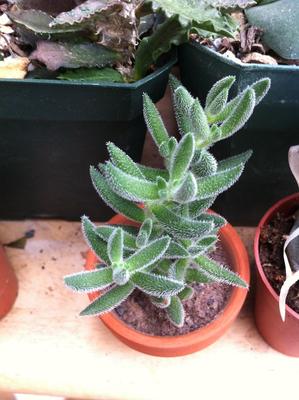
Picked it up at Home Depot in a one inch pot. Fuzzy, pointed leaves. Total height is about 3 inches.
Hi Louise, this appears to be Echeveria setosa or E. pulvinata, which is a little different than many other Echeveria that grow as a rosette.
This one and the many hybrids that are produced with its DNA grow in more of a multi stemmed shrub shape.
Care for it the same way as the others, and watch that you don’t water it with any kind of water that has minerals in, such as well water or tap water as this can mark the leaves on these fuzzy types.
The only one I have currently that is of this type is one of the hybrids, Echeveria set-oliver.
These all show the same general pattern of growth, and sometimes if they’re really happy (and root bound) they will bloom in the late summer with orange and yellow flowers.
Find out more about how to grow Echeveria.
Jacki
thick, dark green leaves
(Israel)
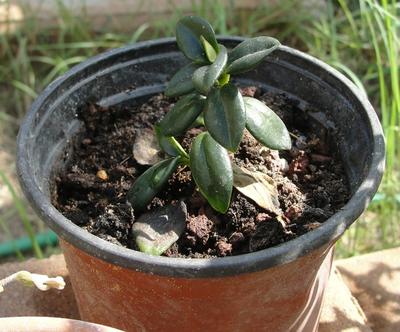
Hi-
Can you help with this one? I think I’ve seen it around with small red flowers, but not at this time of year.
It’s hard to tell with such a small plant but could this be Crassula multicava? Here is a link to more information and maybe you’ll be able to verify it; Fairy Crassula or some kind of Hoya? The flowers will be the most distinctive part, and Hoya blooms are hard to miss. Sorry I couldn’t help much, but that will at least eliminate these two, if it’s not either of them.
Jacki
Jade tree disease
by Mike R
(Chicago, Il)
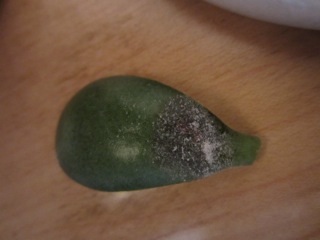




Leaves on my jade tree have some disease process; can you diagnose/recommend treatment or refer me to another site?
Thanks.
Hi Mike, what your plant has are mealy bugs, which have this type of white waxy covering. The odd thing is that usually, these critters prefer to work in secret, such as in the axils of leaves, and the buds of new grow before the leaves open up.
The white powder is probably some kind of fungus that is growing on the ‘honeydew’ of the bugs, and is harmless in itself, although unsightly.
The leaves that are already damaged should be removed, and discarded in the trash so it doesn’t spread.
In fact, one way of combating these kinds of issues – whether it’s bugs of some kind, fungus or just something in the cultivation of the plant that causes damage, you can pretty much defoliate (take all the leaves off) the plant, and it will replace them with healthy ones – all things being equal of course, such as it’s in the right soil (gravelly/sandy/well drained) and it’s getting enough light (bright window facing south or west, getting at least 4-6 hours of sun a day, or under fluorescent lights on a 12 hour regimen)
You haven’t said if it’s all the leaves on the plant, or just one or two.
I would start with that course of action, and although your plant will look odd without leaves for a week or two, new ones will emerge that are healthy.
Keep in mind that these mealy bugs don’t give up easily; you will have to watch the plant constantly, and at the first signs of trouble you can use one of the soap based sprays that most garden centers have – for the best option, look for Safers Insecticidal Soap, either pre-mixed, or you can also get a concentrate.
Mix it to the strength on the bottle.
I usually put some isopropyl alcohol in too, for mealy bugs; use about half a cup for one liter of water, with the soap mixture in. Use immediately, because the alcohol will evaporate off in storage.
Hope that helps,
Jacki
See also my recommendations on a similar issue on a different plant; Soil Sickness? Or something more dire?
Small succulent with long and thin stems, triangle leafs
by Dirk de vries
(Bogota)
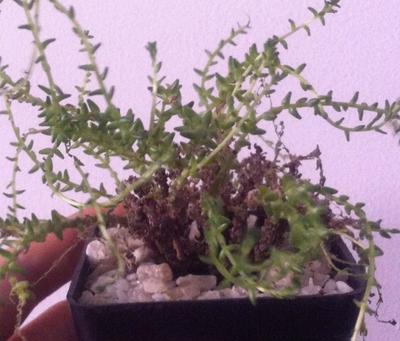
Small succulent with long and thin stems, triangle leafs. Do I have to cut it back once in a while? Does it need a bigger pot?
No experience at all with succulents…
Hi Dirk, your little guy looks like it’s got to be some kind of Sedum, but it’s in desperate need of more light, and yes, indeed, you can cut it back, and repot as needed.
Sorry I can’t identify exactly which one it is, due to the way it’s stretched to get more light.
One thing I usually do, that works well for rejuvenating these types of plants is to chop off the top of the plant, leaving a couple of inches, then take the parts you’ve cut off and put that into a new pot with fresh potting soil. This makes a brand new plant that is perfectly adapted to your conditions.
See more about Sedum and Sedum plants here.
Hope that helps,
Jacki
Learn how to root your own succulents:
What is this?
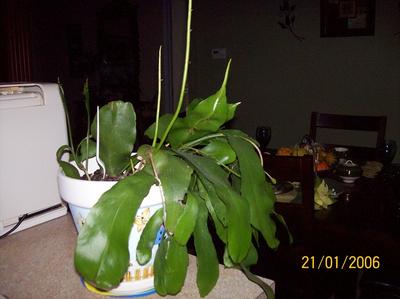
This is a very old plant from my husband’s deceased grandmother; she has been gone for over 20 years and was 99 years old then The leaves are floppy with rows of spines that do not prick the fingers easily. No one in family has a better specimen and no one knows the name of the plant. Can you help?
This is another epiphyte, similar to Epiphyllum, called the Queen of the Night, otherwise known as Hylocereus undatus. Youll be so shocked when it blooms - the heavy scent will wake you from a sound sleep, its so strong.
These plants are long lived, and tend to be grown as legacy plants and handed down to the next generation – you are very lucky and blessed to have such a lovely plant in memory of your forebears.
Happy Succulent Growing!
Jacki
Fuzzy succulent, Looks a little like a miniature palm tree
by Chris
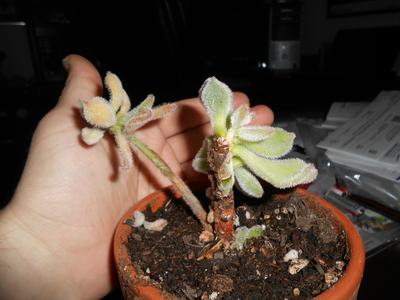
hand by plant to show the size



Picked up this plant at a plant store in Colorado and they could not tell me what it is.
It has two long stems with several leaves sprouting at the top and several little green nubs at the base.
The center stem is almost entirely red while the second diagonal stem started green with a small red spot which has slowly grown over it.
The entire plant is covered in a layer of fuzz, white everywhere except the central stem, where the hair appears to have turned red with the rest of the stem.
The center stem appears to have had the leaves on one half of it removed but appears to be otherwise growing healthy, while the second diagonal stem started with a large compliment of healthy green leaves at the end but has started losing several of them.
The leaves turn yellow then fall off and shrivel up into little white dried out fluff balls in 1-2 days.
The soil was dry when I got it so I watered and it started losing leaves after a few days. I have left it for a week and the soil has dried out but it is still losing leaves on the side stem.
All but two of the leaves have turned yellow and started to die. It has been kept in full sunlight by the back window.
I’d like to know what kind of plant this is and what I may have done wrong so I might be able to save the plant.
Hi Chris, this illustrates perfectly why it’s so important to just say no; no to those little sick plants that just beg to be taken home and looked after. Unfortunately, plants that have been mistreated to this extent are almost always going to have problems.
This is one of the fuzzy Echeveria, of which there are several kinds; the only one I’ve grown to any extent is Echeveria set-oliver, and there are others that are all mixed and mingled together; E. pulvinata, E. setosa and several others are so closely related that they have been interbred.
For your poor little plant, I can only suggest that you take a cutting off the top of the plant, in the hopes that it will root and grow for you. I’ve found that in the case of a plant that has been so badly handled that this is the only way of salvaging anything.
Fingers crossed (buy the e-book!)
Jacki
Learn how to root your own succulents:

